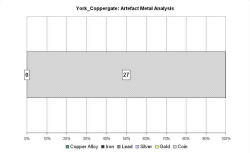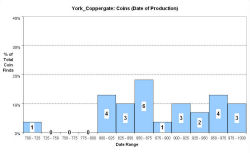Fingerprint charts for i) artefact date analysis, ii) artefact type analysis, iii) artefact metal analysis and iv) coins – date of production




References: Hall 1994; Mainman and Rogers 2000
Archives:
http://ads.ahds.ac.uk/catalogue/search/fr.cfm?rcn=EHNMR-658876
16-22 Coppergate is located between the Rivers Ouse and Foss, c. 220m south-east of the legionary fortress. Excavations took place from 1976-81, followed by watching briefs on the development site. The excavations covered 1000m² but pre-10th-century deposits were only examined in two strips. Publication has concentrated on the finds and faunal assemblages, with only summary information about the excavations themselves.
The first definite post-Roman reuse of the site comprises a glassworking hearth, dated to 860±20. The pre-10th-century pottery assemblage, mostly residual and redeposited material, included typical Middle Saxon wares, including a little Ipswich Ware. Nine Northumbrian stycas were also found, dating no later than c. AD 850. The Coppergate finds assemblage is largely outside the scope of the VASLE project and the sampled dataset includes the coinage from the EMC only, as a control for an urban coin assemblage.
Hall (1994) suggests that at this point there was only sporadic occupation of the site, and whether Coppergate can be considered as a direct successor to Fishergate is debatable.
Fingerprint charts for i) artefact date analysis, ii) artefact type analysis, iii) artefact metal analysis and iv) coins – date of production




© Internet Archaeology/Author(s)
URL: http://intarch.ac.uk/journal/issue25/2/4.4.68.html
Last updated: Tues Apr 21 2009